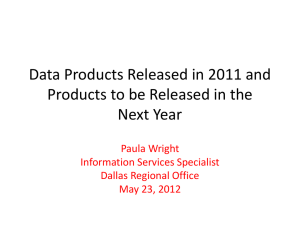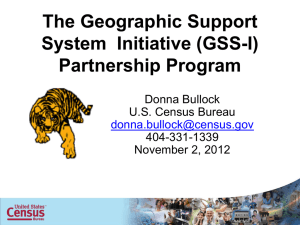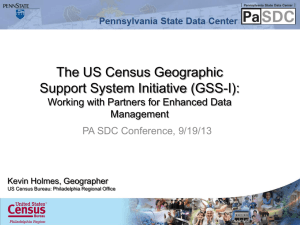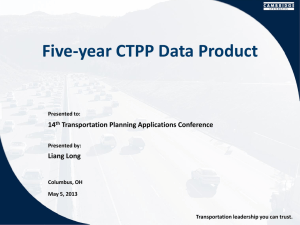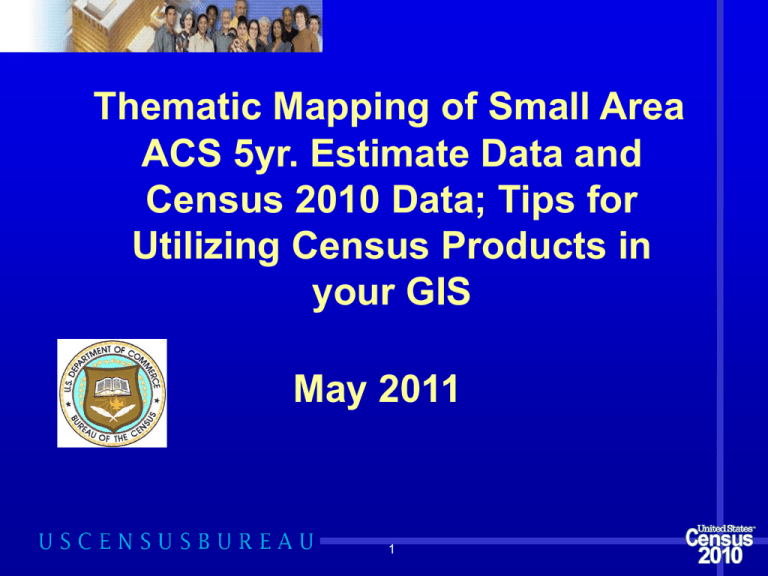
Thematic Mapping of Small Area
ACS 5yr. Estimate Data and
Census 2010 Data; Tips for
Utilizing Census Products in
your GIS
May 2011
1
Items covered in this Presentation:
1. American Community Survey (ACS) data use guidance; ACS vs.
2010 Census.
2. Where to find data from 2010 Census and American Community
Survey (and where to find information on how to use it in GIS).
3. Overview of Basic Steps for utilizing Census data to create
thematic maps or use the data for spatial analysis.
4. The future of Master Address File/Topologically Integrated
Geographic Encoding and Referencing system (MAF/TIGER)
updates.
2
Overview Documentation available online at:
http://www.census.gov/geo/www/tiger/wwtl/wwtl.html
*** This is where to start for using Census data in GIS.
3
2010 results and U.S. House of Representatives:
4
Census 2010 Data Releases
1. State-level counts were released in December, and
these have been used to reapportion Congress.
2. Counts for each county, city, tract, blockgroup, block,
etc. have been released.
3. This data released in the 2010 Census Redistricting
Data Summary Files (more data will be released in
SF1, and further products). All will be available in the
new American Fact Finder system.
5
Data is collected from individuals; aggregate data is released by geographic entity
6
ACS Data Use Guidance
1. 2010 Census shows numbers and basic characteristics (sex, age,
race, hispanic origin, and homeowner status).
2. All ACS data are estimates derived from a sample of the United
States rather than the whole population. Margin of Error (MOE) is
published for each ACS estimate. 250K households in sample
each month, 3 million sampled per year.
3. 2005-2009 ACS estimates represent data collected from January
1, 2005 through December 31, 2009.
4. Much more information/guidance can be found at:
http://www.census.gov/acs/www/
7
ACS Data Release Schedule
Data products are released in the year following the single year or
multiyear period in which data are collected. ACS data includes
median home value, median income, percent foreign-born, percent
without health insurance, etc. This type of demographic data for small
areas (down to tract and block group for the 5yr data) has not been
released from Census since the 2000 long form data releases. This
data replaces the data formerly collected via the Census long form.
l
9
Using Census Data for Thematic
Mapping or Analysis is 4 step process
1. Download appropriate vintage and entity(s) of TIGER/Line
shapefiles.
2. Define the data extract from American Fact-Finder or American
Fact Finder 2 (or FTP complete tables).
3. Manipulate/recalculate tabular data as needed to get the variable
you need, and a GEOID field that will match the shapefiles.
4. Join/Link the TIGER shapefiles to the tabular data using the
GEOID, and symbolize/use as appropriate.
10
Discuss Handouts
11
To get TIGER/Line shapefiles, go to
www.census.gov, then click on TIGER
12
ACS 2005-2009 requires use of 2009 TIGER,
Census 2010 data requires 2010 TIGER.
13
14
15
Download:
16
Download tabular data from American Fact Finder (AFF). The
legacy AFF system will be phased out in 2011, but new AFF
does not have 2005-2009 ACS 5yr estimates. All 2010 data is
in new AFF, and all future data releases will be in new AFF.
17
You may need to calculate a new value for your map.
In this example, I am dividing estimated number of persons
living in poverty by the total estimated persons, and
multiplying by 100 to get the percent living in poverty.
Oftentimes I’ve found it is easier to calculate values
for new values outside of GIS software.
18
To join your tabular data to the shapefile you use versions of the
GEO_ID field:
In the tract shapefile – CTIDFP00
In the ACS data table – GEO_ID2
19
Much care should be used when deciding on thematic
cartographic symbolization, and categorization of data.
Consult Thematic Cartography texts/experts as needed. For
the poverty map, I considered different classification breaks,
and opted for the Jenks classification on the left.
20
2 distinct cultural traits separated by 150 years… similar spatial pattern.
21
Working with 2010 Census Data
- Data downloads from AFF2, or use
Redistricting Summary files (see Tech Tips
on Redistricting/Census website).
- Data uses Geography from 2010 TIGER.
- Data is available for all geographic levels
including the block level.
22
GEO ID for our Census Block:
131210119002026
13 121 011900 2026
13 - state code (GA)
121 - county code (Fulton)
011900 - tract code (aka 119, or 119.00)
2026 - block code (first digit is BG)
23
24
Further Info on Using Census Data in GIS
GA Department of Community Affairs has joined Redistricting Data
Tables with 2010 TIGER/Line and a number of geographies are
available for download, including county, place, tract, block
group, block, SLDU, SLDL:
http://www.georgiaplanning.com/GeorgiaRedistrictingData.htm
If you are interested in hosting any Census Data Workshop, let us
know. Types include: Basics (90 min.), Advanced (3-4 hrs.),
Proposal Writing and Not-for Profit (2.5 hrs.), Media and
Communication Directors (1.5 hrs.), Using Data in GIS (3 hrs.),
and custom.
ArcGIS extension for mapping ACS data and incorporating data
reliability information being developed at George Mason
University, and tool expected sometime this year…
25
The Future of MAF/TIGER Updates…
Need for Continuous updating of MAF/TIGER to support
ongoing surveys such as ACS, and decennial Census
operations.
Geographic Support System (GSS) budget initiative moving
forward in FY2011. Census pursuing funding for 2012 on…
Reliance on local GIS data-sharing partnerships will likely
increase. Local governments have the BEST data.
“Rolling” LUCA..? Web-based partnership systems..? GSS
working groups are researching and planning cost-effective
methodologies for continuous MAF/TIGER feature and
address updates… stay tuned!
26
Questions?
Wes Flack, Geographic Coordinator
john.w.flack@census.gov
Nancy Bechler, Geographer
nancy.bechler@census.gov
Atlanta Regional Census Center
404-332-2711
Atlanta.geography@census.gov
27


